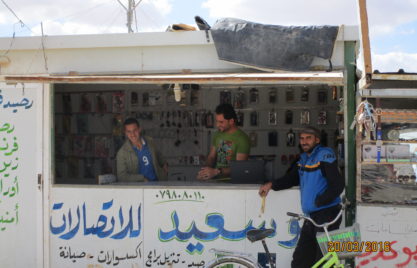Financial inclusion is a relatively new concept for the Middle East and it is a high priority for the Government of Jordan. With the rise of new technology, policymakers and the industry may have to re-think the role of traditional and digital ways to access financial services.
Greater access to financial services promotes social stability, facilitates inclusive economic growth and employment, and stabilises the financial system. In Jordan, only 25% of adults reported having a bank account in 2014, while at the same time the country faces a range of socio-economic challenges, such as the refugee influx and unemployment.
To move forward with financial inclusion, the Central Bank of Jordan (CBJ) committed in 2016 to national financial inclusion goals (AFI Maya Declaration) and launched a multi-stakeholder policy process for the formulation of a National Financial Inclusion Strategy for 2018-20. The CBJ, with the support of GIZ, will inform the policy and sector dialogue trough a study conducted by the Swiss advisory and research firm Business & Finance Consulting. The study will quantify and analyze the access to and usage of financial services by the population in Jordan, including new digital financial services (DFS).
Prioritizing traditional and digital financial services
The World Bank’s global financial inclusion survey (Findex), first conducted in 2011, distinguishes access to financial services between (1) traditional physical access to offices of financial service providers (e.g. a bank branch), and (2) digital access to financial services (via a mobile phone or computer connected to the internet). With the evolution of mobile technology and greater use of mobile phones, financial policymakers and regulators need to carefully consider the role and priority of each of these channels, traditional and digital alike.
Looking at the mobile market, the dynamics reveal a clear transformation in the financial services industry. At the end of 2015, Jordan had 5.7 million unique mobile subscribers (74% of population having at least one subscription). In the same year, 47% of the territory had reliable mobile broadband coverage (allowing for faster 3G and 4G data transfers, including internet access), with an estimate to reach 70% coverage by 2020. In 2016 it was also estimated that over 60% of Jordanians already use a smartphone. On the regulatory side, CBJ established JoMoPay in 2014, which allows for interoperability among all DFS providers and is seen as an international good practice case. All of this has led to the rise of several new payment system providers in the country, which continue to attract new clients using mobile wallets and mobile banking services.
Looking at the traditional branches, despite the fact that these are more expensive to maintain compared to mobile services, such offices will continue to be relevant because of the unique face-to-face customer experience, especially when financial literacy levels are relatively low, as in Jordan. Around 57% of men and 34% of women in Jordan achieved a minimum financial knowledge score (compared to an average of 69% and 56% respectively in OECD countries). Branch offices can inform clients more reliably on adequate financial products, alongside providing business development services. An example are the specialized SME service centers (e.g. with Bank of Jordan, Arab Bank, or Capital Bank), where potential clients receive specific details on financial products for small businesses. While Jordan introduced financial literacy courses in schools in early 2016 to address the younger generations, these service centers directly benefit immediate users of financial services and entrepreneurs.
In the short to mid-term, a rising number of new agents for DFS are expected to be established that can provide clients with information similar to traditional access point. However, these agents might include a variety of outlets such as shops and postal offices that are not as equally professional as traditional bank branches. In the long-run, the evolution of DFS and mobile services will tend to lead to fewer branches. Yet, even in more developed economies physical access points will probably still play an important role. Clients are likely to prefer branches and personal interaction with the provider for advanced financial products and services compared to payments, as well as for filing complaints.
Even if the rise of DFS will lead to changes in the way people use financial services and to some disruptions in the financial landscape, mobile financial services are unlikely to fully replace services by traditional bank branches. The financial regulator will need to carefully consider developments in both physical and digital access to financial services in the National Financial Inclusion Strategy as well as in future policies in this area.
By Artur Vacarciuc, Sofia Bublatzky and Atilla Kaiser-Yuecel
This blog is the first in a series of publications as part of BFC’s Financial Inclusion Diagnostic Study (FIDS) commissioned by GIZ for CBJ. Any opinion expressed here are those of the authors only.



